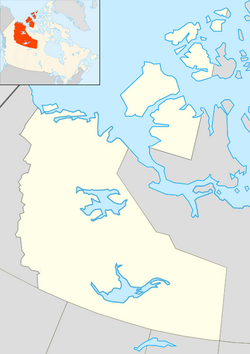Yellowknife, Northwest Territories
|
Yellowknife Sǫ̀mbak'è |
|||||
|---|---|---|---|---|---|
| City | |||||
| City of Yellowknife | |||||

Skyline of downtown Yellowknife
|
|||||
|
|||||
| Nickname(s): "YK", "The Knife", "The Blade" | |||||
| Motto: Multum In Parvo (Latin) (English: Many things in a small place) | |||||
| Coordinates: 62°26′32″N 114°23′51″W / 62.44222°N 114.39750°WCoordinates: 62°26′32″N 114°23′51″W / 62.44222°N 114.39750°W | |||||
| Country | Canada | ||||
| Territory | Northwest Territories | ||||
| Region | North Slave Region | ||||
| Constituencies |
electoral districts
|
||||
| Census division | Region 6 | ||||
| Established | 1934 | ||||
| Incorporation (city) | 1 January 1970 | ||||
| Government | |||||
| • Type | Yellowknife City Council | ||||
| • Mayor | Mark Heyck | ||||
| • Senior Administrative Officer | Dennis Kefalas | ||||
| • MPs | Michael McLeod | ||||
| • MLAs |
List of MLAs
|
||||
| Area (land only) | |||||
| • City | 136.22 km2 (52.59 sq mi) | ||||
| • Land | 105.44 km2 (40.71 sq mi) | ||||
| • Water | 30.78 km2 (11.88 sq mi) | ||||
| • Urban | 13.09 km2 (5.05 sq mi) | ||||
| Elevation | 206 m (676 ft) | ||||
| Population (2011) | 19,234 | ||||
| • Density | 105.44/km2 (273.1/sq mi) | ||||
| • Urban | 18,352 | ||||
| • Urban density | 1,402.3/km2 (3,632/sq mi) | ||||
| Demonym(s) | Yellowknifer | ||||
| Time zone | Mountain (MST) (UTC-7) | ||||
| • Summer (DST) | MDT (UTC-6) | ||||
| Canadian Postal code | X1A | ||||
| Area code(s) | 867 | ||||
| Telephone Exchanges | 444 445 446 669 765 766 767 873 920 999 | ||||
| - Living cost | 117.5 | ||||
| GNBC Code | LBAMG | ||||
| Website | www.yellowknife.ca | ||||
| Sources: Department of Municipal and Community Affairs, Prince of Wales Northern Heritage Centre Yellowknife profile at the Legislative Assembly Canada Flight Supplement ^A 2009 figure based on Edmonton = 100 |
|||||
Yellowknife (English pronunciation: /ˈjɛloʊnaɪf/; 2011 population: 19,234) is the capital and only city, as well as the largest community in the Northwest Territories (NT or NWT), Canada. It is located on the northern shore of Great Slave Lake, approximately 400 km (250 mi) south of the Arctic Circle, on the west side of Yellowknife Bay near the outlet of the Yellowknife River. Yellowknife and its surrounding water bodies were named after a local Dene tribe once known as the 'Copper Indians' or 'Yellowknife Indians', referred to locally as the Yellowknives Dene First Nation, who traded tools made from copper deposits near the Arctic Coast. The current population is ethnically mixed. Of the eleven official languages of the Northwest Territories, five are spoken in significant numbers in Yellowknife: Dene Suline, Dogrib, South and North Slavey, English, and French. In the Dogrib language, the city is known as Sǫ̀mbak'è (Som-ba Kay) ("where the money is").
The Yellowknife settlement is considered to have been founded in 1934, after gold was found in the area, although commercial activity in the present-day waterfront area did not begin until 1936. Yellowknife quickly became the centre of economic activity in the NWT, and was named the capital of the Northwest Territories in 1967. As gold production began to wane, Yellowknife shifted from being a mining town to a centre of government services in the 1980s. However, with the discovery of diamonds north of Yellowknife in 1991, this shift has begun to reverse.
...
Wikipedia





